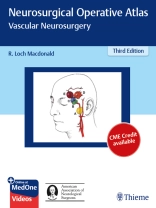A state-of-the-art neurovascular surgery atlas from internationally renowned neurosurgeon R. Loch Macdonald
Neurosurgical Operative Atlas: Vascular Neurosurgery, Third Edition, by R. Loch Macdonald and expert contributors, reflects the latest advances in endoscopic, endovascular, microsurgical, and bypass techniques used in the treatment of cerebrovascular disease. The entire atlas has been streamlined and updated with new content, including 38 videos that complement the concise step-by-step guidance in the text.
The book begins with five chapters on vascular and microsurgical instrumentation and equipment, clipping versus coiling, aneurysm surgery techniques, the pterional approach, and minimally invasive approaches. Disease and procedure-specific chapters are organized by three sections: aneurysms and subarachnoid hemorrhage, vascular malformations, and ischemic and other cerebrovascular disease. Every chapter includes salient tips on patient selection and procedural indications, preoperative information and tests, patient positioning, operative nuances, and postoperative complications.
Key Highlights
- Nearly 300 high-quality color illustrations detail impacted anatomy and procedures
- The latest techniques for treating a full spectrum of aneurysms, such as ophthalmic segment, supraclinoid internal carotid artery, middle and anterior cerebral artery, basilar and posterior cerebral artery, and others
- Treatment of vascular abnormalities including arteriovenous malformations, superficial and brainstem cavernous malformations, arteriovenous fistulae, Moyamoya disease, and more
Neurosurgical residents will benefit from the firsthand knowledge shared by international masters, while veteran neurosurgeons will glean invaluable insights on cutting-edge endovascular techniques to enhance clinical practice.
This book includes complimentary access to a digita
สารบัญ
I Aneurysms/Subarachnoid Hemorrhage
1 Vascular and Microsurgical Instrumentation and Equipment
2 How to Repair This Aneurysm: Clipping or Coiling Decision Making
3 Aneurysm Surgery Techniques
4 Pterional Approach
5 Minimally Invasive Approaches to Aneurysms
6 Opthalmic Segment Aneurysms
7 Supraclinoid Internal Carotid Artery Aneurysms
8 Anterior Communicating Artery Aneurysms
9 Middle Cerebral Artery Aneurysms
10 Distal Anterior Cerebral Artery Aneurysms: Anterior Interhemispheric Approach
11 Pterional Transsylvian and Extended Approaches for Upper Basilar Aneurysms
12 Orbitocranial Zygomatic Approach for Upper Basilar Artery Aneurysms
13 Subtemporal and Pretemporal Approaches for Basilar and Posterior Cerebral Artery Aneurysms
14 Transsylvian Transclinoidal and Transcavernous Approach for Basilar Bifurcation Aneurysms
15 Vertebral Artery and Posterior Inferior Cerebellar Artery Aneurysms
16 Retrolabyrinthine Transsigmoid and Extreme Lateral Infrajugular Transcondylar-Transtubercular Exposures for Aneurysms
17 Vertebral Confluence and Midbasilar Aneurysms Including Transpetrosal Approach
18 Fusiform, Dolichoectatic, and Dissecting Aneurysms
19 Endoscopic Approaches to Intracranial Aneurysms
20 Microsurgical Treatment of Previously Endovascularly Treated Aneurysms
21 Pterional Craniotomy for Exposure of Contralateral Aneurysms
22 Infectious Intracranial Aneurysms
II Vascular Malformations
23 Arteriovenous Malformations of the Cerebral Convexities
24 Arteriovenous Malformations of the Basal Ganglia and Thalamus
25 Intraventricular and Deep Arteriovenous Malformations
26 Vein of Galen Malformations
27 Posterior Fossa Arteriovenous Malformations
28 Superficial Cavernous Malformations
29 Brainstem Cavernous Malformations
30 Spinal Vascular Malformations
31 Carotid Cavernous Fistulas
32 Transverse and Sigmoid Dural Arteriovenous Fistulas
33 Tentorial and Posterior Fossa Dural Arteriovenous Fistulas
34 Anterior Fossa, Superior Sagittal Sinus, and Convexity Dural Arteriovenous Malformations
III Ischemic and Other Cerebrovascular Diseases
35 Carotid Endarterectomy
36 Superficial Temporal Artery to Middle Cerebral Artery Bypass
37 Indirect Bypasses for Moyamoya Disease
38 Positional Compression of the Vertebral Arteries
39 Minimally Invasive Approaches for Spontaneous Intracerebral Hemorrhage












